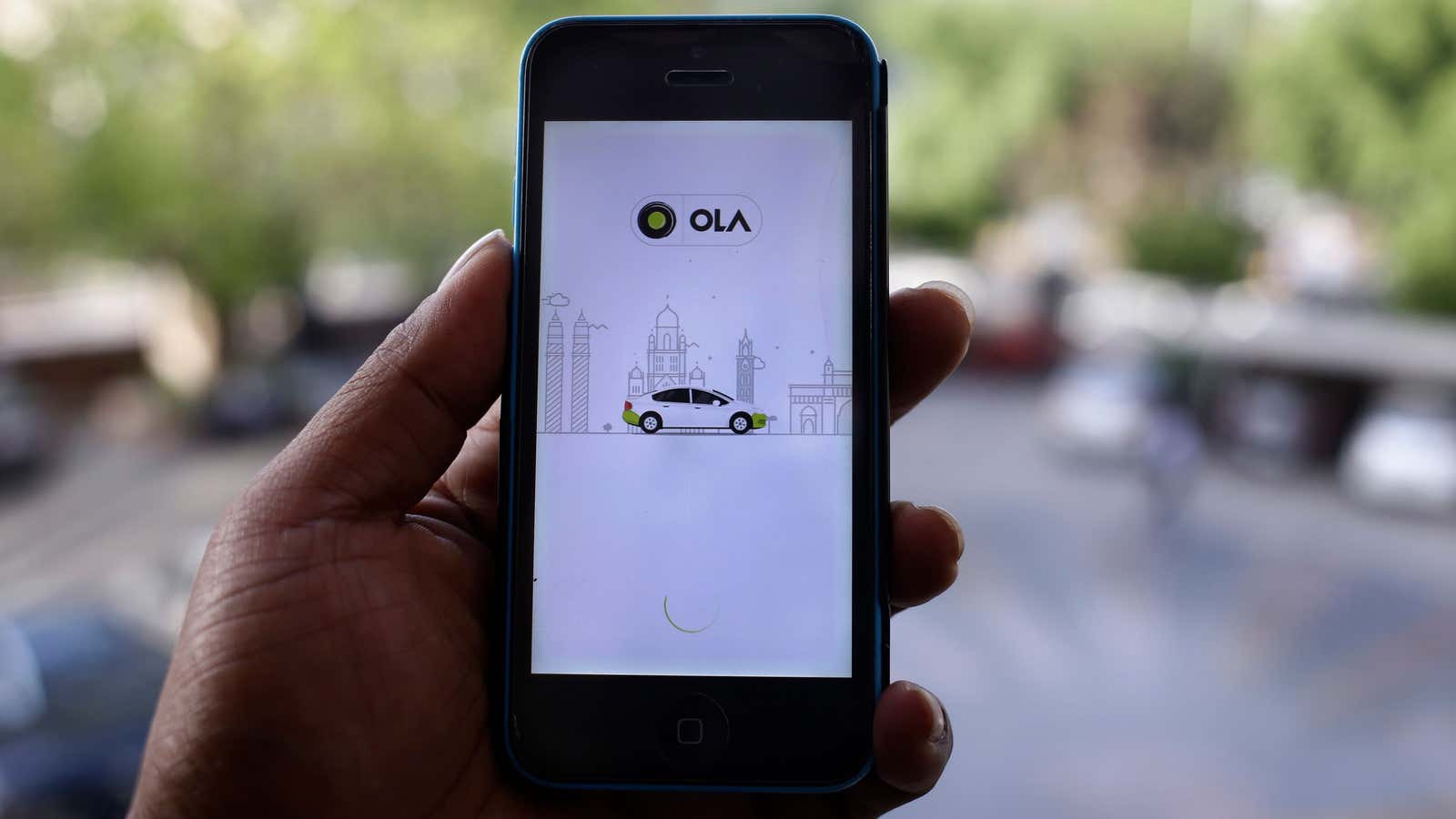Manoj is an Ola driver in Lucknow. Ola owns the car he drives, and Manoj must pay the company about Rs800 ($11.66) every day for three years, after which the vehicle’s ownership will be transferred to him.
Meanwhile, a clutch of rules—some of which he doesn’t even recall breaking—have left him with a negative Ola Money balance and a sworn distaste for the wallet. For instance, in March, he drove his family to a temple outside Lucknow. Since the vehicle crossed the city limits, Ola fined Manoj about Rs500. He says he did not find out about the fine until three days later when he checked his Ola Money balance to find it was negative.
Since then, no customer who opts to pay with Ola Money has seen the inside of his car.
That drivers hate Ola’s mobile wallet is well known to the app’s regular users.
On their first call with drivers after booking a ride, the usual queries on location are followed by ones on the mode of payment: cash or Ola Money.
“The very first question (Ola) drivers ask is if I am going to pay by Ola Money. They are very happy to hear when I tell them that I never use it,” says Chennai resident Partha Krishnaswamy.
Drivers and Ola
Among the several reasons for the hostility towards Ola Money is the fact that drivers need cash to run their daily business. Payments made in Ola Money take about a day to reach their bank accounts. Till then they cannot use the wallet at a gas station or a toll plaza.
“Drivers sometimes call each other from NCR (National Capital Region) toll booths asking to Paytm them Rs60 so they can re-enter New Delhi,” says Ravi Rathore, president of the Sarvodaya Drivers Welfare Association, a cab drivers’ collective based in New Delhi.
A day’s delay in payment would not be so big a concern had the taxi aggregator been more forthcoming with drivers, Rathore said.
Ola deducting fines for breaking rules or against daily commission dues has only added to the aversion. Then there is also a distrust of the app’s algorithm and the company’s support staff.
“Ola has created such a system of deductions that drivers don’t even understand its calculations,” says Rathore.
Shashikant, another Lucknow driver, believes in the principle of “nau nakad na terah udhaar” (a bird in hand is worth two in the bush). He says he stopped accepting Ola Money after recently losing Rs1,000 to fraudsters posing as Ola representatives. Despite approaching the company for redressal, his negative balance hasn’t been cleared.
Commuters and Ola
A similar lack of trust exists among customers, too.
“I was using Ola for a couple of years. They had also provided me Ola Credit of around Rs2,000. But one day, my account got blocked. Some credit was left in my wallet,” says Mumbai resident Animesh Dey. He reached out to Ola but the company refused to specify what went wrong. After that, Dey was forced to open a new account with his other mobile number.
When Dey took to Twitter to ask Ola about the violation, he was offered a cryptic response: “We have validated your concern with our relevant team and been advised that your accounts have been banned due to a violation of Ola policy and procedure. We regret we will be unable to make any changes here.”
The IT professional has since stopped using Ola or other taxi aggregators’ services. “I use public transport now, and I am very happy,” he said.
Besides, with drivers avoiding Ola Money, there’s little reason for customers to use the wallet. And while it is accepted by other online businesses such as Oyo Rooms and Cleartrip, such vendors are far fewer than those offered by bigger competitors like Paytm and Mobikwik. Some companies like BookMyShow, which once accepted Ola Money, have even stopped letting customers pay through it now.
Ola’s plan for Ola Money
Like all mobile wallets, Ola Money got its boost with demonetisation, when its recharges rose by 1,500% in the 15 hours after prime minister Narendra Modi’s announcement. But the Indian economy has since largely returned to cash.
The advent of the government-backed Unified Payments Interface has released a glut of apps that allow transfer of money directly from users’ bank accounts. In addition, the Reserve Bank of India has also made it mandatory for wallet users to fulfil stringent KYC norms, which cuts at the very heart of their much-vaunted convenience aspect.
Ola remains unperturbed, though. “Ola Money continues to grow at a steady pace,” a company spokesperson said, adding that over 50% of its customers have an Ola Money wallet. “Many a time, one tends to get confused between UPI-based payment interface and a wallet. Wallets are more handy for small ticket size payments and they continue to grow.”
But there are signs that Ola has recognised the shortcomings in its wallet.
Last month, for instance, it announced that customers can pay for rides using the UPI-based app, PhonePe. In the same breath, it rebranded Ola Credit as Ola Money Postpaid, suggesting that the wallet may have a more drawn-out lifespan.
“In the coming months, we plan to offer more variations in the postpaid cycle, both time and amount wise, to offer greater convenience to our loyal customers,” Ola’s spokesperson said.
Over the years, the Indian ride-hailing giant has tested a number of unsuccessful ventures, modelled after similar attempts abroad by rival Uber. Ola Cafe came after Uber Eats and Ola Store followed Uber Essentials. By creating its own wallet, however, Ola showed itself to be ahead of the curve. Now the question is whether this move will pay off, and if it does, would the payment be in cash or Ola Money.
